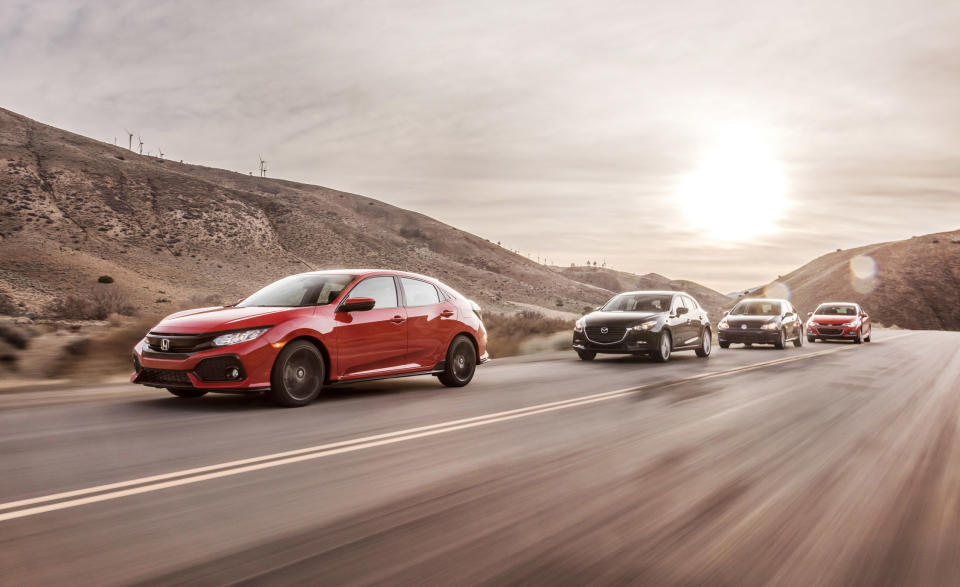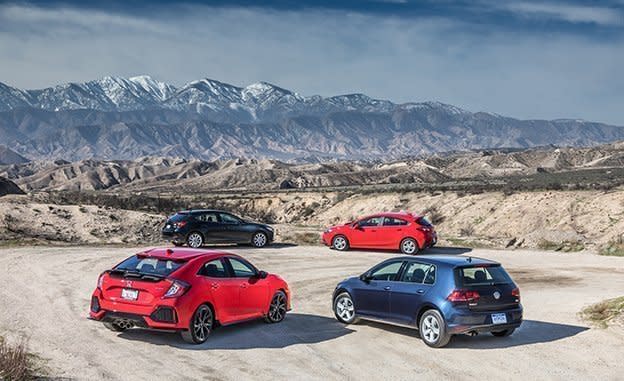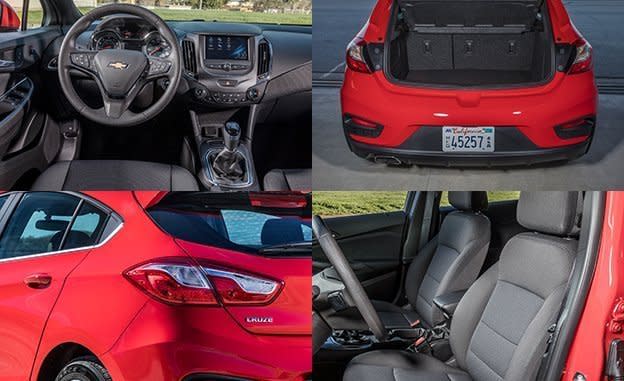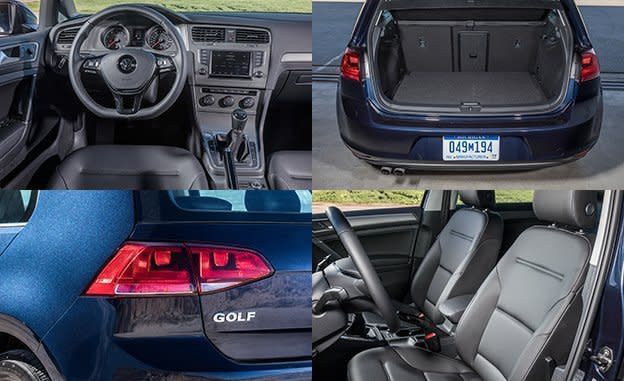2017 Chevrolet Cruze LT RS vs. 2017 Honda Civic Sport, 2017 Mazda 3 Touring 2.5, 2017 Volkswagen Golf Wolfsburg Edition

From the April 2017 issue
“If you could have just one car . . . ?” You’re a car person, so non–car people, who, heaven bless ’em, are just trying to make party conversation, probably ask you this all the time. It’s an absurd question of course, because as every car dude knows, owning just one car is like owning just one sock. But it’s a fun mental exercise and relevant since many of us realistically can’t fit more than one car into our lives.
For this magazine, the ingredients for the One Car are light and tight handling, breezy but not fuel-ravenous power, an efficient interior package that converts quickly from commuter taxi to Home Depot hauler, a manual transmission, and an affordable price that leaves enough dough left over for another car. A convertible maybe, with oil leaks. If BMW would only start an assembly line building low-mileage used E36 wagons, we could end this exercise right here.

Absent that, we submit to you four excellent candidates for mono-auto households. Please note that while they are all hatchbacks, none are crossovers because a tall center of gravity and unnecessary weight do not fit our mission. To this test we mainly invited old friends. Two of our cars, the Mazda 3 and the Volkswagen Golf, in their current forms, have already distinguished themselves in past tests. The Honda Civic hatchback is new for 2017, though the platform, introduced last year, is familiar and much approved of in our office. The Chevy Cruze hatchback also rides on a known hardware set but sails in from Mexico (SAD!) as a newcomer intended mainly for overseas markets. We also asked for the new Subaru Impreza, but manual versions were delayed and unavailable at the time. They should be in stores now.
So how do the members of our quartet fit the template? Even the tallest car, the Cruze, at 57.7 inches, is a low flyer these days. The trim Honda scales at 2868 pounds, and the heaviest car, the VW, is just over 3000. Both are modest figures in this day and age. The most expensive, the fairly loaded Mazda 3 Touring 2.5, asks only $23,330, about a thousand more than the lesser-optioned Chevy and Honda.
The VW proved to be the unlikely racer, using its power and gearing to deliver a sub-seven-second 60-mph time. But all except the snail-slow Chevy were quick enough to merge with verve into a freeway rush. And with a range of 46 to 53 cubic feet of cargo room, all four hatchbacks had ample interior acreage, though with some key differences.
Just one car? you ask. Here is our somewhat windy answer.
Badge confusion. The front end says RS, the old Rally Sport designation that first appeared on 1967 Camaros, while the back says LT, which presumably means Luxury Trim or Latte Tote or something. It could mean Lifeless Torque, but we’ll get to that in a second.
The fact is, the handsome Cruze hatchback, like the Golf, is more of a family capsule than a funmobile. It drives well enough, with okay steering and restrained body motion, the corners absorbed without much drama and the brakes operated by a steady pedal, but there’s no joy in it as there is in the Honda and Mazda. Whereas the Golf feels like a little Mercedes, though, the Cruze just feels like a little Chevy.

Still a lovely thing to behold and to drive, the Mazda 3 remains a great all-around car. But it's not as zesty as the Honda nor as placid as the Volkswagen.
It wasn’t too long ago that you’d need a Porsche to move as quickly as we did in the Mazda through tight curves. Sure, the Honda whupped it on the skidpad and in the slalom, but in the real, eight-tenths world of traffic and guardrails, the Mazda makes time with a confidence that fully masks its humble asking price.
So why third? Despite the relatively healthy horsepower and torque figures, this 2.5-liter free-breather doesn’t stand up to the turbos closing in from all sides. Neither on power nor on fuel economy, which averaged 28 mpg against the amazing turbo Honda’s 31. And getting 185 pound-feet of torque at 3250 rpm is not the same as getting 184 pound-feet at 1600 rpm, as in the VW. All our drivers complained of soft acceleration, especially as we climbed toward our 5900-foot test summit.
The 3’s wheelbase ties the Honda’s and the Cruze’s at 106.3 inches and is longer than the VW’s, but somehow the Mazda has by far the tightest back seat. The Mazda also gives you the least amount of cargo space behind the second row. Another small annoyance: a 12-volt socket buried under the armrest far from the windshield, where the radar detectors and aftermarket nav units live. The ride is also busier than the others, with more vertical motion over choppy pavement. A slightly crisp ride shouldn’t be a ding in a fun car, unless that car is pitted against other cars that deliver stronger performance with a better ride.
The Mazda is more than a pretty face, but it needed to offer just a little bit more to take our One Car trophy.
In terms of the quarreling brothers of Steinbeck’s East of Eden, the Golf is the scrupulous Aron to the Honda’s waggish Cal. One is logical and conservative, in Europe a perfectly acceptable choice for an upright family of four, while the other tries to be wild, with flaring faux ducts and silly winglets and imitation carbon fiber. The Golf is an understated box, its cockpit theme evoking a corporate boardroom with dark hues accented by plastic inserts made to look and feel like brushed metal. You don’t party in the Golf; you do business.
And that lack of self-aggrandizing theater appeals to some of our testers, especially since the Golf delivers both on the road and at the test track. It feels taller and rolls a bit more than its competitors here, but its motions are fluid and athletic and the body feels particularly solid and, well, German, in soaking up road blight.

With the Civic hatchback, Honda designers have selfishly used up the entire world's supply of exterior styling. It is a great car to drive, though.
The other revelation is the turbo 1.5-liter four, a mill that Soichiro Honda would have put on his mantel. It embarrassed the competitors, all flawed in one way or another, by being strong at the bottom, smooth on top, sonorous at any speed, and the thriftiest with the gas. Which is good because Honda is the only manufacturer here that recommends 91 octane. It’s worth it, though, and given the Honda’s outstanding fuel economy on our mountainous drive, it’s probably a wash, cost-wise.
Dropped into a Civic chassis rolling on 235/40 Continental tires, the widest rubber in the test, the engine makes magic. The Civic trounced the others in the grip tests of skidpad (0.93 g), braking (160 feet), and slalom (44.0 mph). It also blew the Mazda away in the hills, bringing turbocharged horsepower and more grip to the task, as well as a better ride. It’s all managed by light and lubricated controls that are a kick to work from the nattily trimmed cockpit. The CRX is long gone, replaced by many lesser successors, so it’s gratifying to see that Honda can still do this stuff when it wants to.

Caveats: Opt for the manual and you get option poverty, even if the thick steering-wheel rim and mushroom-shaped shifter are wrapped in leather. The shifter’s movements could be tighter, and the short gearing means the engine turns a busy 3000 rpm at 75 mph, even if economy doesn’t seem to suffer. The capless fuel filler always resulted in a small puddle on the ground. Does the EPA know about this? Does the EPA still exist?
So, to the original question, here is our answer: The Honda wins because the Civic is the one car that we’d be happiest driving as our One Car. And it’s nice to see that Big H hasn’t completely forgotten who it is.
2017 Chevrolet Cruze LT RS2017 Honda Civic Sport2017 Mazda 3 Touring 2.52017 Volkswagen Golf Wolfsburg EditionVehiclePrice as Tested$22,965$22,175$23,330$22,415Base Price$22,115$22,175$23,230$22,415DimensionsLength175.3 in177.9 in175.6 in167.5 inWidth70.5 in70.8 in70.7 in70.8 inHeight57.7 in56.5 in57.3 in57.2 inWheelbase106.3 in106.3 in106.3 in103.8 inFront Track60.2 in60.5 in61.2 in61.0 inRear Track61.1 in61.1 in61.4 in59.8 inInterior VolumeF: 52 cu ft
R: 42 cu ftF: 55 cu ft
R: 42 cu ftF: 53 cu ft
R: 42 cu ftF: 51 cu ft
R: 42 cu ftCargo BehindF: 47 cu ft
R: 25 cu ftF: 46 cu ft
R: 23 cu ftF: 47 cu ft
R: 20 cu ftF: 53 cu ft
R: 23 cu ftPowertrainEngineturbocharged DOHC 16-valve inline-4
85 cu in (1399 cc)turbocharged DOHC 16-valve inline-4
91 cu in (1497 cc)DOHC 16-valve Atkinson-capable inline-4
152 cu in (2488 cc)turbocharged DOHC 16-valve inline-4
110 cu in (1798 cc)Power HP @ RPM153 @ 5600180 @ 5500184 @ 5700170 @ 4500Torque LB-FT @ RPM177 @ 2000177 @ 1900185 @ 3250184 @ 1600Redline / Fuel Cutoff6500/6500 rpm6500/6700 rpm6500/6300 rpm7400/6800 rpmLB Per HP18.815.916.217.7DrivelineTransmission6-speed manual6-speed manual6-speed manual5-speed manualDriven WheelsfrontfrontfrontfrontGear Ratio:1/
MPH Per 1000 RPM/
Max MPH1 4.27/4.8/31
2 2.16/9.4/61
3 1.30/15.4/100
4 0.96/20.0/130
5 0.74/25.2/132
6 0.61/29.8/1281 3.64/4.9/33
2 2.08/8.6/58
3 1.36/13.1/88
4 1.02/17.5/117
5 0.83/21.5/131
6 0.69/25.9/1311 3.70/5.1/32
2 1.95/9.7/61
3 1.30/14.6/92
4 1.03/19.2/121
5 0.84/22.7/132
6 0.68/28.1/1321 3.78/5.6/38
2 2.12/10.0/68
3 1.27/16.7/114
4 0.86/24.7/125
5 0.66/32.2/125Axle Ratio:13.834.113.853.39ChassisSuspensionF: struts, coil springs, anti-roll bar
R: torsion beam, coil springsF: struts, coil springs, anti-roll bar
R: multilink, coil springs, anti-roll barF: struts, coil springs, anti-roll bar
R: multilink, coil springs, anti-roll barF: struts, coil springs, anti-roll bar
R: multilink, coil springs, anti-roll barBrakesF: 10.9-inch vented disc
R: 10.4-inch discF: 11.1-inch vented disc
R: 10.2-inch discF: 11.6-inch vented disc
R: 10.4-inch disc fully defeatableF: 11.3-inch vented disc
R: 10.7-inch discStability Controlpartially defeatable, traction offpartially defeatablefully defeatablepartially defeatableTiresGoodyear Assurance
205/55R-16 91H M+SContinental ContiProContact
235/40R-18 91W M+SDunlop SP Sport 5000
215/45R-18 89W M+SContinental ProContact TX
205/55R-16 91H M+SC/D Test ResultsAcceleration0–30 MPH2.5 sec2.6 sec2.4 sec2.5 sec0–60 MPH8.3 sec7.0 sec7.4 sec6.6 sec0–100 MPH23.0 sec17.0 sec19.3 sec17.9 sec0–120 MPH38.7 sec27.2 sec33.3 sec31.3 sec¼-Mile @ MPH16.4 sec @ 8815.2 sec @ 9415.7 sec @ 9215.3 sec @ 93Rolling Start, 5–60 MPH9.0 sec7.7 sec7.7 sec7.2 secTop Gear, 30–50 MPH22.5 sec11.7 sec13.5 sec15.0 secTop Gear, 50–70 MPH13.1 sec8.5 sec13.0 sec11.8 secTop Speed132 mph (gov ltd)131 mph (gov ltd)132 mph (gov ltd)125 mph (gov ltd)ChassisBraking 70–0 MPH171 ft160 ft174 ft163 ftRoadholding,
300-ft-dia Skidpad0.85 g*0.93 g*0.86 g0.86 g*610-ft Slalom41.4 mph*44.0 mph*42.0 mph42.0 mph*WeightCurb2881 lb2868 lb2986 lb3010 lb%Front/%Rear61.3/38.759.7/40.359.6/40.459.7/40.3FuelTank13.7 gal12.4 gal13.2 gal13.2 galRating87 octane91 octane87 octane87 octaneEPA Combined/City/Hwy31/28/37 mpg33/30/39 mpg28/25/33 mpg29/25/36 mpgC/D 400-Mile Trip26 mpg31 mpg28 mpg25 mpgSound LevelIdle34 dBA37 dBA38 dBA40 dBAFull Throttle73 dBA82 dBA76 dBA74 dBA70-MPH Cruise65 dBA68 dBA67 dBA65 dBA
*stability-control inhibitedTested by Tony Quiroga, K.C. Colwell, and David Beard in California City, CA
Final ResultsMax Pts. Available2017 Honda Civic Sport2017 Volkswagen Golf Wolfsburg Edition2017 Mazda 3 Touring 2.52017 Chevrolet Cruze LT RSRank1234VehicleDriver Comfort109988Ergonomics109988Rear-seat Comfort55324Rear-seat Space*54555Cargo Space*53544Features/Amenities*1041087Fit and Finish1099108Interior Styling108897Exterior Styling106898Rebates/Extras*50001As-tested Price*2020201919Subtotal10077868279Powertrain1/4-mile Acceleration*2020201814Flexibility*53443Fuel Economy*1010475Engine NVH109995Transmission1088105Subtotal5550454832ChassisPerformance*2020171616Steering Feel109997Brake Feel109898Handling1010997Ride1091088Subtotal6057535146ExperienceFun to Drive2524222215Grand Total240208206203172

* These objective scores are calculated from the vehicle's dimensions, capacities, rebates and extras, and/or test results.

 Yahoo Autos
Yahoo Autos 